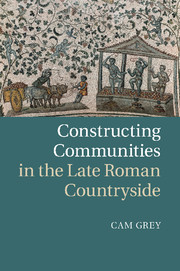Book contents
- Frontmatter
- Contents
- Preface
- List of abbreviations
- Map The late Roman world (sites and regions discussed in the text)
- Introduction
- Chapter 1 Constituting communities
- Chapter 2 What really matters
- Chapter 3 Small politics
- Chapter 4 Power as a competitive exercise
- Chapter 5 Resistance, negotiation, and indifference
- Chapter 6 Creating communities
- Chapter 7 Unintended consequences
- Conclusions
- Bibliography
- Index
Chapter 1 - Constituting communities
peasants, families, households
Published online by Cambridge University Press: 07 September 2011
- Frontmatter
- Contents
- Preface
- List of abbreviations
- Map The late Roman world (sites and regions discussed in the text)
- Introduction
- Chapter 1 Constituting communities
- Chapter 2 What really matters
- Chapter 3 Small politics
- Chapter 4 Power as a competitive exercise
- Chapter 5 Resistance, negotiation, and indifference
- Chapter 6 Creating communities
- Chapter 7 Unintended consequences
- Conclusions
- Bibliography
- Index
Summary
Scholarship on the peasantry of the late Roman world has tended to view them as if down the barrel of a telescope, analyzing socio-economic relationships and strategies from the point of view of the demands and pressures that the state and its aristocracies placed upon them. This chapter constitutes a first step towards inverting that telescope, and looking back up it to see how the concerns, politics, and constraints of individual peasants and their communities might simultaneously have impacted upon their interactions with each other, with more powerful figures, and with the state. I do this by focusing attention upon explicating and defining the components of rural communities, and sketching the relationships between them. I suggest that, while the evidence for the composition of rural communities in the period is anecdotal and patchy, it is possible to construct a plausible picture of the individuals and groups that might have constituted those communities. As our analysis moves progressively from the individual, through the family and household to the community, the balance between theoretically informed supposition and empirically derived proposition will gradually shift. That is, while we are somewhat limited in the concrete conclusions we can draw about intra- and inter-household relations, we can with a certain degree of confidence offer some hypotheses about the structure and makeup of a variety of rural communities in the period.
I begin with a discussion of terminology, exploring both the boundaries around specific entities and the fundamental importance of focusing upon connections between those entities. This project presents considerable challenges. To what extent is it reasonable to speak of the peasantry as a concrete, discrete class? How are we to determine the composition of the “typical” peasant household, and is the exercise analytically useful? What is a community? In what follows, I propose a twofold approach to these questions. First, I suggest that we must identify and define these entities, but that those definitions must be flexible enough to encompass the immense diversity of economic niches, social systems, and physical environments that constituted the rural contexts of the late Roman world. In pursuit of this project, I connect existing debates in the social sciences with the evidence that survives from the period. Here, and in the following chapters, I argue for the general applicability of analytical categories and concepts drawn from comparative literature, while emphasizing the uniqueness of each particular community.
Information
- Type
- Chapter
- Information
- Constructing Communities in the Late Roman Countryside , pp. 25 - 57Publisher: Cambridge University PressPrint publication year: 2011
